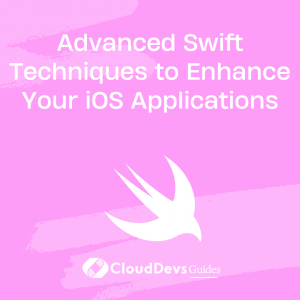Advanced Swift Techniques to Enhance Your iOS Applications
Swift, introduced by Apple in 2014, has rapidly become the language of choice for not just iOS developers, but also businesses looking to hire Swift iOS developers. Its powerful syntax, safety features, and flexibility have ushered in a new era of iOS application development. While the language’s basic syntax is straightforward enough for any developer to grasp, its advanced features offer a treasure trove of tools that can significantly enhance your applications.
Whether you’re a seasoned programmer or a company aiming to hire Swift iOS developers, understanding these advanced techniques can truly help level up your iOS apps. This post will explore these potent Swift features in depth.
1. Generics
Generics are a fundamental Swift feature that promotes code reuse and helps maintain a clean, organized codebase. This powerful feature can be used to write flexible and reusable functions and types.
Let’s say we want to write a function that can swap the values of two variables, regardless of their type. Without generics, we would need to write separate functions for each data type. However, with generics, we only need to write the function once:
```swift
func swapTwoValues<T>(_ a: inout T, _ b: inout T) {
let temporaryA = a
a = b
b = temporaryA
}
var someInt = 3
var anotherInt = 107
swapTwoValues(&someInt, &anotherInt)
var someString = "hello"
var anotherString = "world"
swapTwoValues(&someString, &anotherString)
2. Protocol-Oriented Programming
Swift is known for its support of protocol-oriented programming, a programming paradigm that emphasizes the concept of protocols. Protocols define a blueprint of methods, properties, and other requirements that suit a particular task or piece of functionality.
Consider a scenario where we have different types of vehicles, each with a different way to start. With protocol-oriented programming, we can define a `Vehicle` protocol, and have each vehicle conform to it:
```swift
protocol Vehicle {
func start()
}
class Car: Vehicle {
func start() {
print("Starting the car with the key.")
}
}
class Motorbike: Vehicle {
func start() {
print("Kickstarting the motorbike.")
}
}
let car = Car()
car.start()
let motorbike = Motorbike()
motorbike.start()
This way, we ensure that all vehicles have a start function without needing to implement it for each vehicle manually.
3. Optionals
Optionals are Swift’s solution to the problem of null-reference exceptions. They indicate the absence of a value or the presence of a value. An optional in Swift treats “no value” as a first-class citizen, making it safer and more expressive.
```swift var possibleString: String? = "An optional string." var absentString: String? = nil
Here, `possibleString` is an optional string that does contain a string, and `absentString` is an optional string that contains no string.
4. Error Handling
Error handling is a key feature that allows a program to respond to error conditions during execution gracefully. Swift provides first-class support for error handling with the `do-catch` syntax.
```swift
enum PrinterError: Error {
case outOfPaper
case noToner
case onFire
}
func send(job: Int, toPrinter printerName: String) throws -> String {
if printerName == "Never Has Toner" {
throw PrinterError.noToner
}
return "Job sent"
}
do {
let printerResponse = try send(job: 1040, toPrinter: "Never Has Toner")
print(printerResponse)
} catch {
print(error)
}
In this example, if an error is thrown within the `do` block, it is matched against the `catch` clauses to determine which one of them can handle the error.
5. Functional Programming Features
Swift incorporates several features from functional programming, including first-class and higher-order functions. These features allow functions to be passed as parameters, returned as values from other functions, and assigned to variables.
```swift
let numbers = [1, 2, 3, 4, 5]
let squaredNumbers = numbers.map { $0 * $0 }
print(squaredNumbers) // prints [1, 4, 9, 16, 25]
In this example, the `map` function is a higher-order function that takes a function as its argument.
6. Swift Extensions
Extensions are a powerful feature in Swift. They allow you to add new functionality to an existing class, structure, enumeration, or protocol type. This includes the ability to extend types for which you do not have access to the original source code.
Let’s say we want to add a method to the built-in `Double` type that converts degrees to radians:
```swift
extension Double {
var radians: Double {
return self * .pi / 180
}
}
let degrees = 180.0
print(degrees.radians) // prints 3.141592653589793
7. Property Observers
Property observers observe and respond to changes in a property’s value. They’re called every time a property’s value is set and can be used to perform additional actions. Swift provides two kinds of property observers: `willSet` and `didSet`.
```swift
class StepCounter {
var totalSteps: Int = 0 {
willSet(newTotalSteps) {
print("About to set totalSteps to \(newTotalSteps)")
}
didSet {
if totalSteps > oldValue {
print("Added \(totalSteps - oldValue) steps")
}
}
}
}
let stepCounter = StepCounter()
stepCounter.totalSteps = 200
// About to set totalSteps to 200
// Added 200 steps
Conclusion
Swift provides a rich set of features and techniques that can dramatically enhance your iOS applications, making it a sought-after skill for companies looking to hire Swift iOS developers. These advanced techniques not only offer the potential to write cleaner, more maintainable, and more efficient code, but also make your portfolio more attractive if you’re seeking opportunities as a Swift iOS developer. With these tools in your toolkit, you’re not just on your way to becoming a Swift power user, but also more marketable in the competitive landscape of iOS development. So whether you’re an individual developer or a company aiming to hire Swift iOS developers, mastering these techniques can lead to remarkable improvements in your iOS apps. Happy coding!
Table of Contents









